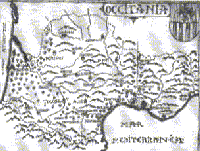
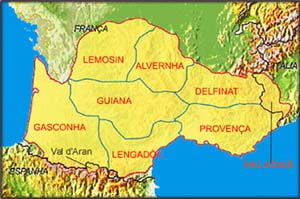
Occitania is the name given to the area where Occitan, the langue d'oc, was traditionally the first language. It covers almost half of modern France (the Midi - the sothern part excluding the Basque Country and the Roussillon which is Catalon speaking) along with parts of what are now Italy and Spain. This area is far larger than the modern region of the same name and covers the present day Regions of Limousin, Languedoc-Roussillon, the old Aquitaine, and the southern part of the French Alps. It encompasses not only cities like Toulouse, Montpellier, Carcassonne, Narbonne, Nîmes, and Béziers but also ones as far spread as Nice, Marseilles, Clermont-Ferrand, Limoges, Pau, and Bordeaux.




 The
area has a long history of liberty and has always provided
refuge to thos suffering persecution. A few examples are:
The
area has a long history of liberty and has always provided
refuge to thos suffering persecution. A few examples are:
- Faidits - dispossed Cathars - who were given help during their persecution by crusaders and the Inquisition. So too the Waldenians and other Religious Dissidents.
- Sephardic Jews. Jews were not persecuted under the The Counts of Toulouse as they were elsewhere in western Christendom, and as they were in the Languedoc after it was annexed to Catholic France in the fourteenth century. After1492, Navarre became a refuge for Spanish Jews, persecuted by the Spanish Inquisition and later for Catalonian Jews.
- The Camisards. These were Protestants heavily persecuted by French Catholics who sought and recieved succour in the Lozère in the sixteenth, seventeenth and eighteenth centuries.
- Spanish Political Refugees. After the Spanish Civil War which ended in 1939, many Spaniards were welcomed throughout Occitania. Spanish surnames are still common in many areas.
- The Maquis. The Maquis were resistance fighters who opposed the German occupation of the Midi (and the earlier puppet Vichy Government). They were widely sheltered and supported, despite the risks, just as the faidits had been 700 years earlier.
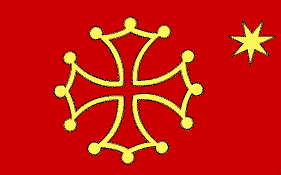
![]()

 This
territory has never known political unification, but most
of it was ruled by the Counts
of Toulouse, or their vassals, in the early Middle Ages.
It is still united by its common language, as well as a
large number of cultural similarities food, architecture,
attitudes, and way of life. There is a small
independence movement, similar to that supporting independence
for Catalonia.
Its flag, based on that of the Counts of Toulouse with the
Cross
of Toulouse, is shown on the left. It was drawn up by
the independentist PNO (PartitNacionalista Occitan). It
features the Occitan
cross and the Felibrige star, yellow on a red background.
The seven armed star is a reference to the seven poets who
founded the Felbridge on the 21 May, the day of the Santa
Estela (Holy Star).
This
territory has never known political unification, but most
of it was ruled by the Counts
of Toulouse, or their vassals, in the early Middle Ages.
It is still united by its common language, as well as a
large number of cultural similarities food, architecture,
attitudes, and way of life. There is a small
independence movement, similar to that supporting independence
for Catalonia.
Its flag, based on that of the Counts of Toulouse with the
Cross
of Toulouse, is shown on the left. It was drawn up by
the independentist PNO (PartitNacionalista Occitan). It
features the Occitan
cross and the Felibrige star, yellow on a red background.
The seven armed star is a reference to the seven poets who
founded the Felbridge on the 21 May, the day of the Santa
Estela (Holy Star).

![]()
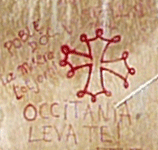
![]() A
favourite French argument against Occitan independence is
that the words Occitan
and Occitania are modern inventions. This is not true. The
terms were used by the official administration in the fourteenth
century, in such terms as 'lingua occitana', 'respublica
occitana', 'patria linguae occitanae' and 'Occitania'. Another
favourite argument relys on the fact that Occitania has
never been an independent country. This is itself arguable,
but even if the point is accepted, it is notable that neither
were Germany nor Italy before the end of the 19th century.
Neither was India, nor dozens of other countries until the
Twentieth.
A
favourite French argument against Occitan independence is
that the words Occitan
and Occitania are modern inventions. This is not true. The
terms were used by the official administration in the fourteenth
century, in such terms as 'lingua occitana', 'respublica
occitana', 'patria linguae occitanae' and 'Occitania'. Another
favourite argument relys on the fact that Occitania has
never been an independent country. This is itself arguable,
but even if the point is accepted, it is notable that neither
were Germany nor Italy before the end of the 19th century.
Neither was India, nor dozens of other countries until the
Twentieth.
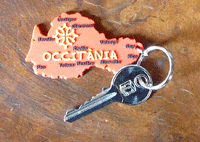 |
|
||||||||||







